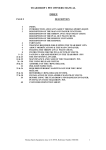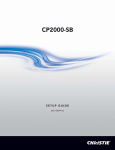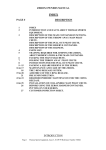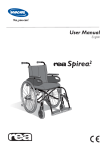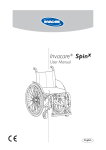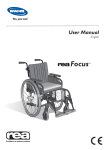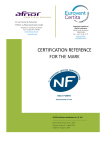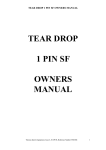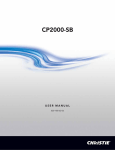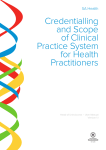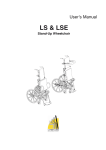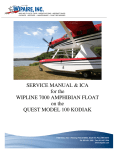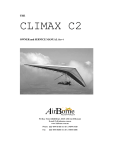Download Codes of Practice
Transcript
HEALTH AND SAFETY CODES OF PRACTICE PRODUCTION DEPARTMENT Table of Contents 1 INTRODUCTION 5 2 GENERAL 5 3 ACCESS ROUTES 7 4 ASBESTOS 8 5 AUTOMATED EQUIPMENT 8 5.1 Royal Festival Hall 8 5.2 Queen Elizabeth Hall 9 5.3 Purcell Room 11 6 CABLE MANAGEMENT 11 7 EMERGENCY LIGHTING 12 8 GAS 12 9 GELS 12 9.1 Cutting Gels 12 9.2 Fitting Gels 13 10 GENIE SUPALIFT/ GENIE RUNABOUT/ UPRIGHT AB 38 (CHERRY PICKER)/ GENIE GS 3232 (SCISSOR LIFT) 13 10.1 General safe use of these pieces of equipment 13 11 FLAME EFFECTS 13 12 LADDERS 14 12.1 Safe use of ladders 14 12.2 Rearing and extending ladders 15 12.3 Placing of Ladders 15 12.4 Working from a Ladder 16 12.5 Folding Steps and Trestles 16 13 LASERS 16 2 Doc: Production codes of practice Date: December 2010 Version 7 14 LOADING AND UNLOADING 17 15 LOLER: A SIMPLE GUIDE TO THE LIFTING OPERATIONS AND LIFTING EQUIPMENT REGULATIONS 1998 18 16 LONE WORKING 18 17 MANUAL HANDLING 18 18 OVER HEAD WORK 19 19 POWER SUPPLIES 19 20 PUWER: A SIMPLE GUIDE TO THE PROVISION AND USE OF WORK EQUIPMENT REGULATIONS 1998 20 21 PUBLIC AREAS 21 22 REPLACING THEATRE LAMPS 21 23 RIGGING A CYC / BACKCLOTH 22 24 RIGGING LANTERNS 22 24.1 General rigging 22 24.2 Boom stands 23 24.3 Box outlets 23 24.4 Designers plan 23 25 RIGGING WORKS OF ART/INSTALLATIONS 24 26 ROOF SPACES & VOIDS 25 26.1 Notification of Access / Exit Procedure 25 26.2 Solo Access Forbidden 25 26.3 Radios 25 26.4 Rules for Working in the Roof 26 26.5 Royal Festival Hall Roof Space Procedures 27 26.6 Queen Elizabeth Hall Roof Space Procedures 28 26.7 Purcell Room Roof Space Procedures 29 26.8 Hayward Gallery 30 3 Doc: Production codes of practice Date: December 2010 Version 7 27 SMOKE AND VAPOUR EFFECTS INCLUDING PYROTECHNICS 30 28 STROBE LIGHTING AND LUMINAIRES 31 29 TALLESCOPES 31 29.1 31 Use of the Tallescope 30 WATER 33 4 Doc: Production codes of practice Date: December 2010 Version 7 1 Introduction These Codes of Practice are applicable to all those who work in the Southbank Centre (SC) and who may use or come into contact with any of the equipment detailed in this document. It is essential that all within the Production Department have read and understand these safe working methods. These Codes are issued to all contractors who carry out work within the Southbank Centre. Prior to contractors working on site they are to be approved by the production team in conjunction with the health and safety department. In conjunction with these Codes of Practice SC’s Health and Safety Policy should also be read and adhered to. Ed Smith Technical Director 2 General All personnel are responsible for their own safety, the safety of others, and to notify any incidents of unsafe practice and/or defective equipment immediately to the Duty Production Manager, Technical Supervisor or Nominated Fire Person (security team leader). All accidents and near misses are to be reported to Security or the Health and Safety Team. The following people should ensure risk assessments are in place: Duty managers – risks to the public during performances in auditoria Production – for the get in and get out of a production/event and the stage area Visiting companies to provide risk assessments for what they are doing at the venue Producers or organisers – for exhibitions, private events, workshops and work placements 5 Doc: Production codes of practice Date: December 2010 Version 7 Contract managers – for any work contracted out on site to ensure a risk assessment is obtained from the contractor for the work they are doing A documented risk assessment is needed where a work activity poses a significant risk, the types of events that would fall into this category would be if the activity involved one or more of the following: Any public attendance When a high risk activity is taking place such as pyrotechnics being used, complex structures (seating/stages) If there is political or controversial content If there are noise issues to consider If the event starts or finishes outside core opening times In some cases Production will require further detail and a method statement will need to be provided. The Production Manager will ensure that all those involved are aware of the significant risks. All personnel should wear the appropriate personal protective equipment suitable to the work activity, e.g. steel toe caps, hearing protectors, gloves, high visibility clothing, etc. Tools and material when not clipped to all employees are to be in proper tool boxes, tool bags or containers. Never leave tools or equipment lying around haphazardly, particularly at high level, as they can easily be kicked or knocked down. Lanyards, tool pouches or other suitable equipment should be used. While working with access equipment and machine tools within SC, the following rules must apply: Compliance to all manufacturers’ recommendations All personnel requiring use of access equipment within SC must have had prior formal training in the use of the equipment including manual handling. Proof of this may be required The creation of an exclusion zone beneath and around the access equipment ensuring the safety of members of the public, staff, and artists. This area will be indicated by the installation of appropriate signage The lighting levels should be adequate and the weather conditions should not present a risk All equipment should be appropriately maintained and meet the legal requirement, e.g. PAT tested and appropriate for use. All work for installations, performances, events should be scheduled to ensure enough time is given to carry out the task safely and that enough employees are available. 6 Doc: Production codes of practice Date: December 2010 Version 7 It is recognised that the usual patterns of work dictate that long hours will often be worked by in house and visiting touring company employees in the getting-in, fitting-up and getting-out of productions. It is further recognised that in order to complete the work, breaks have tended to be eroded. However, the safety of employees must never be compromised and wherever practicable employees do not work for more than an average of 48 hours in each seven days averaged over a 17 week period and a break of 11 hours is given in between each working day and employees are not forced to work more than 6 days in every 7 or 12 days in every 14, in accordance with the Working Time Regulations (WTR). Where it is occasionally necessary to work through breaks Production Managers and Touring Managers will ensure that safety is not compromised and that the rest periods are taken as soon as possible within that shift. All personnel working in the SC must familiarise themselves with the emergency exit routes and procedures, the position of fire fighting equipment, and first aid points relative to where they are working. In special circumstances operation of equipment or work practices can only deviate from this code of practice subject to a formal risk assessment being undertaken and conditions of the risk assessment being fully applied and agreed by management at SC. Anyone under the influence of alcohol or drugs should not use any of the equipment listed in this document. If you have any medical condition or are on any medication that may affect your ability to use the equipment safely or may affect those working around you the Duty Production Manager should be notified. Care should be taken when carrying out work activities that there is no unauthorised access to any work area or piece of equipment. The Southbank Centre Health and Safety policy is available on request and should be adhered to at all times. 3 Access Routes Safe access and egress routes from the buildings should be maintained at all times. When work is being carried out the area should be cordoned off to prevent any unauthorised access and warning signage in place. If the layout of an area is changed, e.g. in the galleries, a safe access and egress route must be maintained and agreed with Health and Safety. 7 Doc: Production codes of practice Date: December 2010 Version 7 Access to all technical areas must be planned and hazards removed. Where access is difficult all employees and freelancers must be shown the area and become familiarised with the route. 4 Asbestos Throughout the SC there are certain areas where there are some asbestos containing materials, these areas have been inspected and deemed safe and in good condition. Under no circumstances must any structural alterations be carried out or any changes to the fabric of the buildings made unless the asbestos register (which is held in the Buildings and Estates Department) has been consulted and approval has been given by the Head of Buildings and Estates or the Production Manager. 5 Automated Equipment 5.1 Royal Festival Hall Only members of the production crew of Southbank Centre who have been trained and authorised are permitted to operate the automated stage system. Prior to operation of the automated stage system the area must be clear of members of the public and it must be made clear by the use of signage and monitoring of the area that no entry is permitted whilst the stage is being moved. It is good practice to operate one solo system at a time, however if circumstances are such that it is necessary to operate more than one system at a time then there needs to be a minimum of 3 production crew present who are monitoring and controlling the situation. At least two of those crew members must be positioned in the correct areas. When the solo system is in operation there must be no sound system in operation so that any instruction can be heard. The instruction must be clear and audible to all those involved in the movement of the stage. Adequate lighting must be on so that there is sufficient lighting for the operation of the automated system. The stage should be moved and put into place prior to any visiting orchestras, bands or companies arriving. However if it is necessary to make changes to the stage once people have arrived then it must be clearly communicated to all those that are in the area and the stage must be clear of people before movement commences. A risk assessment for the different types of concert or show is to be provided prior to each event. 8 Doc: Production codes of practice Date: December 2010 Version 7 Production crew using the automated solo system less than once a month must have refresher training once a year by a competent trained person in the use of this piece of equipment. Should any unsafe practices be witnessed by a member of the production crew in this piece of equipment then they must attend a refresher training course prior to using the piece of equipment again. If a fault is encountered with the system then the operating procedure should be consulted. For further information please refer to the Solo Handheld Controller User Manual Movement of seating Any seating to be moved from the auditorium should be carried out by the production team who have been trained in the safe handling and movement of the seats. If this work is subcontracted out then the SC Production Staff should oversee this work to ensure these safe working procedures are being followed. The seats are unscrewed from the base plate and manually lifted on to the trolley that is going to be transporting them from the auditorium. Gloves should be worn by those moving the seats. Some seats taken from the auditorium can be placed in an orderly manner in the choir lobbies right and left in the marked storage areas set aside for these seats only. This maintains the required clear access routes in the event of an emergency. Any excess seats that cannot fit in this set aside area are to be placed in storage. Trolleys are to be used to transport the seats in a safe manner and a safe lifting technique is to be used by production crew in the movement of these seats. Due to the weight of the seats they should be moved by a minimum of 2 production crew. When returning the seats they must be put back in exactly the same way as they have been taken out to ensure they fit correctly. They are screwed back in to place on the base plate. 5.2 Queen Elizabeth Hall Movement of the stage Only members of the production crew of Southbank Centre who have been trained and authorised are permitted to operate the stage system. Prior to operation of the stage system the area must be clear of members of the public and it must be made clear by the use of signage and monitoring of the area that no entry is permitted whilst the stage is being moved. The stage can only be moved up or down and only one section at a time can be moved. 9 Doc: Production codes of practice Date: December 2010 Version 7 When the system is in operation there must be no sound system in operation so that all instructions can be heard. The instruction must be clear and audible to all those involved in the movement of the stage. Adequate lighting must be on so that there is sufficient lighting for the operation of the system. The stage should be moved and put into place prior to any visiting orchestras, bands, conferences or companies arriving. However if it is necessary to make changes to the stage once people have arrived then it must be clearly communicated to all those that are in the area and the stage must be clear of people before movement commences. A risk assessment for the different types of event is to be provided prior to each event. Production crew using the system less than once a month must have refresher training once a year by a competent trained person in the use of this piece of equipment. Should any unsafe practices be witnessed by a member of the production crew in this piece of equipment then they must attend a refresher training course prior to using the piece of equipment again. If a fault is encountered with the system then the operating procedure should be consulted. 2x1m sections for the orchestra pit are load tested to 5 ton each section. These should be installed by production crew only who have been trained in the installation of the panels, if however, due to unforeseen circumstances the sections are put in by freelancers or contractors then they must be signed off by an authorised member of the production crew prior to use. Flying system/Camtrak Bars 1-8 (subject to current working practice – chain hoist) Only members of the production crew of Southbank Centre who have been trained and authorised are permitted to operate the Flying system. Ibex system (chain hoist) Mother grid and trusses 9 - 12 Only members of the production crew of Southbank Centre who have been trained and authorised are permitted to operate the Ibex system. There should be 4 spotters in place when the mother grid is moved when the Ibex system is in operation. If a fault is encountered with the system then the operating procedure should be consulted. An instruction manual is available with this kit. Literature set The literature set is 6m high incorporating a projection screen that is put in place for literature events. The set takes up the full width of the stage. The screens are stored locally. 10 Doc: Production codes of practice Date: December 2010 Version 7 The lifting of each piece of set must be directed by an authorised member of the SC Production crew. A minimum of 6 production crew are required to put the whole of the set in place. QEH Portal set This is for front of house masking down stage left and right and is 8.5m high. A member of the production crew of Southbank Centre who has been trained and authorised to operate this piece of equipment must always oversee the safe use of this. The top section is flown in the auditorium on a chain hoist. Sections are added, there should be a minimum team of 6 people assembling this, using the correct lifting techniques. Procedure for doing sidemasking flats (wings) These must only be installed by trained competent SC Production crew and a minimum of 4 people are to be present when doing this. The appropriate number of weights and braces will be applied. 5.3 Purcell Room Movement of temporary portable stage This is currently under review for modernisation. The stage must be moved with a minimum of 6 people and it must be supervised by a member of SC Production crew. 6 Cable Management Whenever possible safe levels of working light should be applied. While it is understood that cable management cannot be applied until all systems have been proved to be working correctly, every effort should be made to apply safe working practices at the earliest opportunity. While applying loose cabling, whenever possible, areas which are a means of access and egress should be avoided. Wherever possible routing of cables should avoid areas where they may cause a trip hazard, i.e. under-stage areas and flying whenever possible. Special attention should be applied when running cables along lighting bars; sideframes; and moving trusses and bridges, to avoid hanging loops which may cause snagging problems and trip hazards. Whenever possible looming of cables for the maximum length of run possible is always the preferred method. 11 Doc: Production codes of practice Date: December 2010 Version 7 Special care must be taken by all staff and in-coming contractors to be aware of any loose cabling on / or behind stage to which cable management cannot be applied. While installing break-out boxes for audio, visual and electrical cabling every effort should be made to position these boxes to afford the optimum cable management system. Suggested methods of covering cables to prevent a tripping hazard are: Rubber matting. Hazard taping. Cable ramping must always be applied when crossing through routes for vehicles and forklift trucks. Luminous tape should be employed when ambient lighting conditions are at low level. Cable ties. If any holes are formed in the walls to run cabling through then intumescent bags should be used to fill any holes to maintain the fire integrity of the surface. 7 Emergency Lighting Emergency lighting is maintained on a regular basis by the Maintenance Department. These lights must not be obscured in any way and any changes to the layout of a room, such as use of scenery or change in Gallery layout, should be agreed prior to the work taking place by the Production Manager, Maintenance Manager and Health and Safety. 8 Gas If working with gas bottles they should be stored in a suitably sized lockable cage for storage. The gas cage should be secured at all times and all bottles should be put away at the end of the working day. All empty gas bottles must be removed from site on a regular basis and this must be stored in a vertical position. 9 Gels 9.1 Cutting Gels Whenever possible safe levels of working light and space should be applied. Any cutting of gels using a blade should be carried out using a purpose made cutting board on a level surface. 12 Doc: Production codes of practice Date: December 2010 Version 7 9.2 Fitting Gels When fitting the gel the frame chosen should be in good working order with all retaining clips present and functioning. Special care should be taken in choosing the correct frame for the fitting being utilised. Wherever possible gel frames should be fitted with the lamps at a safe working position; under safe level of working lights; and at a safe temperature. Whenever fitting gels at height, care should be taken to ensure the safety of any people working below. When gels are fitted to light fittings, all safety retaining clips should be utilised. Personal protective equipment is employed, where relevant. The side frames in the QEH are hung on steel ropes, which are inspected on a regular basis. Only trained competent SC Production crew are permitted to use these frames until the trap doors have been fitted. Gels must not be fitted over any emergency lighting. 10 Genie Supalift/ Genie Runabout/ Upright AB 38 (cherry picker)/ Genie GS 3232 (scissor lift) 10.1 General safe use of these pieces of equipment See separate manufacturers operating instructions on the correct use of these pieces of equipment. Only trained, competent SC Production crew are permitted to use them. They are always stored in BOH areas to prevent any unauthorised use. 11 Flame Effects SC has an overall policy of no naked flame on site. However there may be occasions where to have tea lights, candles or real flame effects present using appropriate control measures would be so low risk as to permit naked flame to be used. If real flame is required then a Risk Assessment detailing the event and the control measures that will be in place should be produced and sent to the Health and Safety team. In all cases the naked flame must be sited away from curtains, fabrics and soft furnishings. On some occasions a security person with a fire extinguisher will be required to be on hand and the risk assessment may also require additional control measures. 13 Doc: Production codes of practice Date: December 2010 Version 7 12 Ladders 12.1 Safe use of ladders Ladders are inspected regularly by the Health and Safety team and a record kept. It should be ensured that the ladder to be used has been inspected, this will be indicated by a Southbank Centre foil label being fixed to it with a unique number. The Health and Safety team should be notified of all new ladders so that they can be added to the ladder register. Any contractors bringing their own ladders in for use must ensure that they are maintained and fit for purpose. Production team carry out a visual inspection twice a year of the ladders that they use and record this. In addition to this Production visually check the ladder prior to use, if any defects found remove from use and ensure it is adequately labelled to prevent someone else from using it until it has either been repaired or replaced. The vertical height from the ground to the ladders point of rest should be four times the distance between the foot and the vertical. Ladders should be securely fixed near to the upper resting place, or footed by an individual, or secured at the base to prevent slipping. The correct placing of a ladder will not prevent accidental displacement unless it is properly footed and secured. Never climb a ladder without first looking it over to ensure that it is in fact safe. Feet should be placed firmly well into the rungs. Appropriate PPE should be worn. Carrying materials up or down ladders should be discouraged. Heavy tools can be hoisted by hand lines, providing there is an area where they can be safely placed. Other heavier materials are best hoisted by using a gin-wheel or other mechanical means separate from the ladder. Ladders should only be used: Where you can maintain three points of contact (hands and feet) at the working position. On a ladder where you cannot maintain a handhold, other than for a brief period of time, other measures will be needed to prevent a fall or reduce the consequences of one Where they will not be struck by vehicles, by protecting them with suitable barriers or cones Where they will not be pushed over by other hazards such as doors or windows, by securing (not fire exits) and windows where possible. If this is impracticable, have a person standing guard at a doorway, or inform workers not to open windows until they are told to do so 14 Doc: Production codes of practice Date: December 2010 Version 7 Where pedestrians are prevented from walking under them or near them, by using barriers, cones or, as a last resort, a person standing guard at the base When they are long enough, the top three rungs should not be used and it should project at least 1m above the landing point Ladders can be put at the correct angle of 1 unit out for every 4 units up When they are wearing robust, sensible footwear, e.g. safety shoes/boots A non-conductive ladder or steps should be used for any necessary live electrical work. Ladders should not be rested against weak upper surfaces, e.g. glazing or plastic gutters. 12.2 Rearing and extending ladders A short step or rung pole ladder is easily raised by one person by restraining the base of the ladder against a solid object, the top can then be lifted and walked rung by rung, hand over hand, until finally upright. The foot can then be slid or lifted into its final position. Larger heavier ladders require more assistance and possibly a rope over a fixture to help control it. At all times during raising and lowering a ladder, adequate weight must be applied to the base, it is often necessary to have two people footing to prevent the ladder becoming uncontrollable and kicking. 12.3 Placing of Ladders The foot of the ladder should rest on a firm non slippery surface. A person can be stationed at the foot to hold it firm: the person should stand on the bottom rung with both hands holding the stiles and remain motionless. Firm contact at the top of the ladder is most important; the surface must be firm and sound, to prevent top slip. A bracing board should be attached to the top of the ladder, or stand offs. 15 Doc: Production codes of practice Date: December 2010 Version 7 12.4 Working from a Ladder Ladder workers should keep both feet and one hand in contact with the ladder whilst working. ‘Two handed’ tasks require a properly constructed platform. Where ladders are used in public places, the areas around the base should be cordoned off and appropriate notices displayed. 12.5 Folding Steps and Trestles With steps and trestles the following precautions should be observed: Spread the steps to their fullest extent. Ensure that the cords are of adequate length and in good condition and firmly knotted. Whenever possible place steps at right angles to the work to reduce the chance of a sideways movement upsetting them. Never stand on the top step or tread unless it is constructed as a platform and has a secure hand hold. Folding steps should never be used for supporting a working platform since they are neither wide enough to take minimum width of two boards or strong enough for this purpose. Trestles must be a minimum of 17 inches wide to accommodate two boards. A span of 5 feet must never be exceeded with an inch and a half thick scaffold boards. 13 Lasers Lasers produce very intense light beams, which could blind, cause skin burns or even start fires if used improperly. The installation and operation of any laser should comply with the Radiation Safety of Lasers used for Display Purposes and BS EN 60825 Parts 1 and 4. Any laser beams should be at least 3m above the highest affected floor level at al times and arranged so that they cannot scan onto any member of the public, performer or employee. Supporting structures should be rigid to avoid any accidental misalignment of lasers. The Production Manager should ensure that the use of lasers is carried out by a competent trained person, is included in the risk assessment and informs Health and Safety that it is being used. 16 Doc: Production codes of practice Date: December 2010 Version 7 14 Loading and Unloading The production arch situated off of the service road is used for the getting-in and getting-out of production equipment for the RFH. The QEH service road is used for the unloading of equipment for the QEH and Hayward Gallery. When visiting companies, touring companies, production companies and delivery companies are visiting SC the general rule is that they are responsible for the loading and unloading of their vehicle and they should provide an adequate number of personnel to do this safely. However there may be occasions when SC employees assist in the loading and unloading of vehicles. It is for the visiting company to appoint a competent person to supervise the loading and unloading of vehicles. This person should be easily identifiable, for example by wearing a distinctive high visability jacket. This person will supervise those who are loading and unloading the vehicle. A loading plan/method statement of how the vehicle will be loaded or unloaded safely will be asked for by a SC representative, if one is not available then a dynamic risk assessment will be carried out of the load and all those involved in the work activity will be fully aware of the safe working practices that should be followed. If the SC employee is asked not to assist in loading and unloading then they will not assist or if the SC employee feels that the load has not been stacked safely or the practices being used to load or unload the vehicle are not being carried out safely the SC employee will refuse to assist and stop the operation. The supervisor of this activity will be trained in how their vehicle operates, that tail lifts are working and operating correctly, the safe loading, they have the necessary licences and will have the risk assessment for the work they are carrying out. SC staff, if they are helping in loading and unloading the vehicle should take direction from the supervisor to ensure it is carried out safely and also liaise with the supervisor to advise of the site arrangements. The Production team accepting a delivery will ensure that the area is clear of other traffic, pedestrians and people, that the ground is level for the person to make the delivery and that the area is well lit. A delivery plan will be agreed with the supplier and the production team, as to the safest area that items can be dropped and that the delivery driver will be in overall charge of the loading/unloading of the vehicle. If the load appears to have shifted dangerously in transit then everyone should keep clear of the vehicle and make sure the area is kept clear. Only those who have received training in manual handling and are wearing suitable safety footwear will be able to assist. Employees to only lift within their own capabilities. 17 Doc: Production codes of practice Date: December 2010 Version 7 15 LOLER: A simple Guide to the Lifting Operations and Lifting Equipment Regulations 1998 In accordance with the above Regulations, all lifting equipment used at SC shall be: Strong and stable enough for the particular use and visibly marked to indicate safe working loads Positioned and installed to minimise any risks Used safely, i.e. the work is planned, organised and performed by competent people Subject to ongoing thorough examination and where appropriate, inspection by competent people: Equipment used to lift people should be subjected to at least six monthly examinations; all other equipment should be inspected at least annually. Each examination must be detailed in a report Lifting equipment includes any equipment used at work for lifting or lowering loads, including attachments used for anchoring, fixing or supporting it. The regulations cover a wide range of equipment including, cranes, forklift trucks, lifts, hoists, mobile elevating work platforms, and vehicle inspection platform hoists. The definition also includes lifting accessories such as chains, slings, eyebolts etc. 16 Lone Working Employees working alone must always carry means of communication, radio preferably, and ensure that security is aware that they are working on their own. Some areas of the SC, such as roof areas, and high risk work activities require a permit from the Health and Safety team and do not permit lone working. A permit to work in high risk areas must be obtained prior to the work commencing. 17 Manual Handling All Production employees involved in lifting of equipment will be trained in how to lift correctly and the assessment process with regard to manual handling. Where possible the need for manual handling should be avoided, items to be moved are at a manageable size or weight or mechanical aids should be utilised. Where not possible an assessment is carried out which identifies the following: 18 Doc: Production codes of practice Date: December 2010 Version 7 The load The individual The task The environment Contractors/freelancers carrying out work that involves manual handling will be required to provide an assessment detailing the above. 18 Over head work Only qualified, competent persons are permitted to carry out this work, who are fully conversant with the latest Regulations regarding safe working heights and distances for overhead wiring. Prior to any overhead work being carried out a risk assessment and method statement must be provided to the Production Manager detailing what work is being carried out and what safe working practices are going to be employed. The Production Manager will be responsible for ensuring that persons carrying out this work are competent to do so and that safe working practices are being followed. 19 Power supplies While working with electricity within SC all incoming contractors will be required to comply with the working practices as outlined by the Electricity at Work Regulations 1989, made under the Health and Safety at Work Act 1974; and in compliance with the current IEE regulations. It is the responsibility of all contractors to ensure that all personnel in their employ are fully conversant with these regulations. Notification must be given to the Head of Building and Estates at the Southbank Centre for any electrical work being undertaken. Any proposed electrical work undertaken on productions must be agreed by the Head of Building and Estates. It is the responsibility of all contractors to ensure that all personnel in their employ responsible for connecting equipment into permanently installed electrical outlets are suitably competent for these tasks. No work can be carried out without a SC Production crew member being present. 19 Doc: Production codes of practice Date: December 2010 Version 7 On no account should any incoming contractor connect any supply directly to potentially exposed live conductors without first consulting the Duty Production Manager or Technical Supervisor. Whilst working on potentially live conductors, it is essential that the following practices apply: No less than two competent personnel should be in attendance at all times. Personnel must be fully conversant with the Southbank Centre emergency procedures. In addition to this, they must be aware of the position of the nearest fire fighting equipment and how to call for first aid assistance. It is the responsibility of in-coming production companies to ensure that the equipment they supply is maintained to a level consistent with safety requirements and legislation. The SC Production manager will ensure that the work is carried out safely by visiting companies and the equipment being used is safe, this will be inspected by the Production Manager prior to the opening of the event. Any health and safety issues raised during an event will be discussed and recorded either in the Production Manager’s meeting or the monthly meeting with Health and Safety. 20 PUWER: A simple Guide to the Provision and Use of Work Equipment Regulations 1998 In accordance with the above Regulations, all equipment used at SC shall be: Suitable for the intended use Safe for use, maintained in a safe condition and in certain circumstances, inspected to ensure this remains the case Used only by people who have received adequate information, instruction and training Accompanied by suitable safety measures, e.g. protective devices, markings, warnings All damaged equipment shall be reported to the production manager, suitably tagged and removed from use and it must not be used until it has been repaired by a qualified person and signed as safe to use. 20 Doc: Production codes of practice Date: December 2010 Version 7 21 Public Areas Any work that is carried out in areas open to members of the public should be scheduled so that it is carried out before or after normal core opening hours. If, in certain circumstances, this is not possible then the area where work is being carried out must be adequately and suitably cordoned off to prevent any unauthorised access. Security assistance may also be required to ensure people do not enter the marked off area. 22 Replacing Theatre Lamps Procedure to follow when replacing a tungsten halogen bulb: Ensure that all power is isolated Wait for the lamp to cool Never touch the envelope as it is under pressure and may explode Remove lamp Continuity check on lamp Insert new lamp and ensure all connections are clean and tight Restore power. Procedure to follow when replacing CSI, HMI or xenon bulb: Ensure that all power is isolated Allow 20 minutes for the lamp to cool Put on protective clothing supplied Place safety cover over lamp as soon as possible Remove lamp Insert new lamp Remove safety cover Ensure all connections are clean and tight Restore power, and turn down amps where required for initial striking 21 Doc: Production codes of practice Date: December 2010 Version 7 After approx 10 Hrs use check connections are still tight. Always use protective clothing when lamphouse is open. This should consist of Face Mask (Plastic Visor), Heavy Duty Apron and Heat Resistant Gloves. 23 Rigging a Cyc / Backcloth Recommended method: Whenever possible, safe levels of working light and space before undertaking the task. Check that the cloth and its hanging ties or bungies are in good working order. Ensure that the Cyc / Backcloth that is being flown are of a class 1 fire resistance. Cyc / Backcloth stretchers should be installed at a safe working height. Any stage weights and braces should be clearly marked to avoid trip hazards. Once the Cyc / Backcloth is flown, ensure that it is not impeded by equipment that may cause a hazard. Maintain a safe distance from any sources of heat (e.g. lamps, projection equipment). Wear suitable personal protective equipment (PPE) when and where relevant. 24 Rigging Lanterns 24.1 General rigging Ensure items for hanging and associated equipment are ready for use and are PAT tested: Carry out visual inspection of all electrical items to be used e.g. lanterns, multicore and cables. Hang lanterns using hook clamps and secondary safety bonds: Check lantern weight before handling and rigging. Check for hook clamps not fastened and missing safety bonds. Ensure safety bonds are used on every unit. Insert colour frame and colour: Check frames are securely positioned. Insert barn doors, gobo / iris, colour changer (where these are applicable): Check all attachments are fixings are operational, correctly used and secure. 22 Doc: Production codes of practice Date: December 2010 Version 7 Cable up to cable runs and multicores: Check cables, plugs, sockets, multicore insulation are safe and operational. Ensure multicore and cable are securely and tidily attached. Ensure all units are rigged in designated position and pointing in approximate direction (as per rig plan). Flash through to check circuits are working, numbered and all units are operational. 24.2 Boom stands Care and attention should be paid to the condition and weight to height ratio, and suitable bracing should be employed as necessary. Positioning of the boom stands should be clearly marked to avoid collision by artists or crew. Due care and attention should be applied to the phasing of the supply to the booms. Phasing separation should be maintained in accordance with HSE guidelines. Ensure that all tank traps are in good working order. 24.3 Box outlets Regular checks on the conditioning and phase labelling of all outlets should be employed. Use of these outlets should be restricted to competent personnel only. 24.4 Designers plan Adequate time needs to be spent assessing the lighting plan. Check availability of equipment against lighting plan: Ascertain area phasing and do not cross phase within a 3 metre distance. Load equipment: Consideration given not to exceed the weight capacity of lighting bars. Ascertain from plan how many circuits are required and their location: The electrical installation should be maintained to a standard that should a fault occur that protective devices will operate. Derig concert rig lanterns not required: Institute and maintain regular overhaul and inspection of equipment and protective devices. Time slots for stage / lighting / and sound operations, and appropriate breaks should be allocated. 23 Doc: Production codes of practice Date: December 2010 Version 7 General good housekeeping of the Hayward Gallery BOH, QEH basement area, the RFH Level 3 and the RFH basement area. All safety equipment used as per manufacturers recommendations. 25 Rigging works of art/installations Anyone who is going to use moving equipment of any type backstage must be trained to understand the purpose of the equipment and the proper methods of operation. No one should be allowed to handle any rigging equipment unless they are properly trained. Many more accidents are caused by untrained users than by faulty equipment. Pre-consultation to take place prior to the installation so that the work is planned and scheduled in to allow enough time to safely carry out the task. A pre-set design to be provided prior to the event, if required. When carrying out any rigging work the following precautions must be followed: Pay attention to what is happening around you Remove unnecessary items from your pockets and belt, and secure any needed tools to your body Wear a hard hat when required Wear heavy duty work gloves where appropriate Wear safety shoes Do not wear loose fitting clothes and jewellery Tie long hair back Only use maintained rigging equipment Ensure safety bonds are used on every unit Never work on your own Safe lifting techniques to be used Never exceed safe working load 24 Doc: Production codes of practice Date: December 2010 Version 7 26 Roof Spaces & Voids 26.1 Notification of Access / Exit Procedure Any staff or contractor requiring access to any roof spaces and voids must employ the following procedures prior to and whilst working in any roof space of SC: No-one can access the roof without a roof permit unless they are on the approved list and have undergone an SC induction. Roof permits for those people that are not approved can be obtained from the Duty Production Manager, Duty Technical Supervisor, Health and Safety, Head of Building and Estates or Maintenance Manager. Access at any time must be by prior arrangement without exception. Having gained permission or a permit, security must be contacted on 0666 and be told who is going into the roof and why they are entering the roof space. They must also be contacted when you leave the area on the same number. If no induction has been carried out the person must be accompanied by someone at SC who has been inducted at all times. Radio communication should be taken when working on the roof. Whilst in the roof space, special attention must be paid to potential moving equipment. Any equipment painted orange has the potential to move. Anything yellow could be a movement plinth. Do not cable over the yellow beams! Should you find yourself in difficulty due to movement of equipment, hitting an estop or pulling the red cords will stop any movement. 26.2 Solo Access Forbidden Please note that solo access for external contractors is forbidden. A minimum of two contractors should go into the roof at all times. Should there need for SC Production crew to go into the roof space, they must inform security and be on comms or in radio contact with another member of Production crew. Security must be notified when work is finished in the roof space. 26.3 Radios Radios are required in the above specified areas. Please test your radio when walking into any roof space or void. 25 Doc: Production codes of practice Date: December 2010 Version 7 26.4 Rules for Working in the Roof 21.6.1. The following rules apply to all working in the roof spaces and voids unless otherwise indicated in the table above:No loose gear is to be taken into the roof voids. Tools and material when not clipped to all employees are to be in proper tool boxes, tool bags or containers. Never leave tools or equipment lying around haphazardly, particularly at high level, as they can easily be kicked or knocked down. Lanyards, tool pouches or other suitable equipment should be employed. Personnel are not to leave the walkway unless conforming to the same personal safety equipment and training practices as specified in the Code of Practice for Rigging. Walkways are, at all times, to be kept clear of loose gear, equipment, ropes, etc. All gear taken into the roof space and not used is to be removed after work is completed. Smoking is NOT allowed in any of the roof spaces and voids. Food of any sort is never to be taken into the roof void. Certain areas within our working environment have been identified with containing asbestos material. These areas have been inspected and on expert opinion deemed safe and in good condition, however, providing that the material remains undisturbed. No work on or near asbestos may be organised or carried out without reference to the Head of Buildings and Estates (see Asbestos.) 26 Doc: Production codes of practice Date: December 2010 Version 7 26.5 Royal Festival Hall Roof Space Procedures Side Walls Organ Loft Organ Loft Void Organ Door Slots FoH lighting bridges Raked Seating Void Grand Tier Seating Voids Followspot Galleries Circle Spots External Roof Ducts H A L L Under Stage F E S T I V A L Roof Space R O Y A L Notification of access/exit procedure Solo access forbidden * * * * * * * * * * * * * Radio required Designated hard hat area * Safety harness must be worn * * Before proceeding to work in any of these areas it is necessary to familiarise yourself with the Health & Safety requirements below:- Area exclusion and signage Tools clipped to body * * * * * * * Dependant on Circumstance 27 Doc: Production codes of practice Date: December 2010 Version 7 26.6 Queen Elizabeth Hall Roof Space Procedures Solo access forbidden * * Radio required Designated hard hat area * Safety harness must be worn Area exclusion and signage * * * * * * Tools clipped to body Ducts External Roof Projection Room Canopy Followspot Galleries Control Boxes Under Extended Stage Under Stage Notification of access/exit procedure H A L L Raked Seating Void Before proceeding to work in any of these areas it is necessary to familiarise yourself with the Health & Safety requirements below:- Side Frames Bridges and Side Boxes E L I Z A B E T H Roof Space Q U E E N * * * * * * * * * * * * * * Dependant on Circumstance 28 Doc: Production codes of practice Date: December 2010 Version 7 26.7 Purcell Room Roof Space Procedures Control Boxes Ducts Notification of access/exit procedure Raked Seating Void Before proceeding to work in any of these areas it is necessary to familiarise yourself with the Health & Safety requirements below:- Under Stage R O O M Roof Space P U R C E L L * Solo access forbidden * * * Radio required Designated hard hat area * * * * * * Safety harness must be worn Area exclusion and signage Tools clipped to body * * Dependant on Circumstance 29 Doc: Production codes of practice Date: December 2010 Version 7 26.8 Hayward Gallery Sculpture courts Loading bay Ducts Notification of access/exit procedure Plant rooms Before proceeding to work in any of these areas it is necessary to familiarise yourself with the Health & Safety requirements below:- Roof Space HAYWARD GALLERY Solo access forbidden * Radio required Designated hard hat area Safety harness must be worn Area exclusion and signage Tools clipped to body * * * * * * * * * * * * * * * * Dependant on Circumstance 27 Smoke and Vapour Effects including Pyrotechnics Smoke effects and pyrotechnics can only be used when under the control of people competent in that activity. The Production Manager is to be warned in advance that smoke effects and/or pyrotechnics are to be used and a separate risk assessment will need to be provided for the product being used. People involved in the production/event should be warned in advance that smoke effects are to be used. A test should be carried out prior to opening the production or event to determine if any isolations are required of the smoke detectors and appropriate storage must be provided. Cryogenic (low temperature) fogs are produced using dry ice (solid carbon dioxide) or liquefied gas (generally liquid nitrogen or liquid synthetic air. The gases released by conversion from the solid or liquid form can displace the normal atmosphere, including the oxygen in the air, to become an asphyxiant (except liquid synthetic air, which includes oxygen). Use of these fogs must be strictly controlled and monitored, see separate risk assessment for these products. 30 Doc: Production codes of practice Date: December 2010 Version 7 Warning notices should be displayed stating that smoke effects or pyrotechnics are being used. These notices should be displayed at all public entrances to the premises by the Duty Manager so that the public may read them before entering. It is essential that the Production Manager informs the Duty Manager when these effects are being used so that they are included on the risk assessment. 28 Strobe lighting and Luminaires Where stroboscopic effects are used in public areas, the sources should be synchronise and locked off to operate at a frequency outside the band of 4 to 50 flashes per second. Stroboscopic lighting units should be mounted at high level and wherever appropriate the beams deflected off matt surfaces to reduce the glare. Strobes should not be sited on escape routes, corridors or stairs or other changes of level. Warning notices should be displayed stating that stroboscopic lighting operates as part of the effects on the premises. These notices should be displayed at al public entrances to the premises by the Duty Manager so that the public may read them before entering. It is essential that the Production Manager informs the Duty Manager when strobes are to be used and that they are included on the risk assessment. 29 Tallescopes 29.1 Use of the Tallescope The tallescope is stored in the Purcell room as this is where it is used, it is stored behind the curtain near to the stage and it is ensured that when not in use it is secured to the wall and a width of 1.1m is maintained between that and the seating in the auditorium. It is essential that only employees who have been trained in the use of this piece of equipment are permitted to use it. Before tilting ladder upright: The tallescope must be level, and the leg locks must be engaged or the locking nut closed Check overhead clearance before extending and retracting the platform After tilting the ladder upright: Ensure security hooks are engaged Check that all hook castings on braces and platform bearers are firmly installed, and that spring loaded plungers are engaged 31 Doc: Production codes of practice Date: December 2010 Version 7 Never adjust the legs with a person on the tallescope and do not stretch the platform height by using them. The legs should be used for levelling only. Outriggers must never be removed from the tallescope, but folded back when in transit. When in use the width across the outriggers should be one third of intended platform height. In space restricted areas further control measures need to be employed, see separate risk assessment. Before Moving the Tallescope: Ensure that there are no materials on the platform Ensure that no one is on the Tallescope Ensure that the Tallescope is not damaged, that locking collars and locking pins are effective Moving the Tallescope Ensure that there are sufficient people at the base of the tallescope to move it safely. Use a minimum of two people. Under no circumstances should the Tallescope be moved with someone on it Working from the Tallescope Engage all wheel brakes before climbing the tallescope Never lean too far over the safety rails Never use boxes, ladders, or climb into the safety rails on the platform to gain extra height If equipment is pulled to the top of the tallescope keep the load within the wheelbase of the tallescope Before Tilting Ladder Down: Remove all tools and other equipment from the platform and tool bag Ensure that ladders are fully closed and engage ladder locking latch Ensure a clear area for the ladder to descend Maintenance Keep the tallescope, especially the moving parts, clean, and lightly oil the locking collars and locking pins Do regular visual checks 32 Doc: Production codes of practice Date: December 2010 Version 7 30 Water If water is to be used as part of a feature or an event this should be discussed with the Head of Buildings and Estates to determine if any further treatment of the water is required and what monitoring needs to be carried out to ensure water quality. 33 Doc: Production codes of practice Date: December 2010 Version 7



































